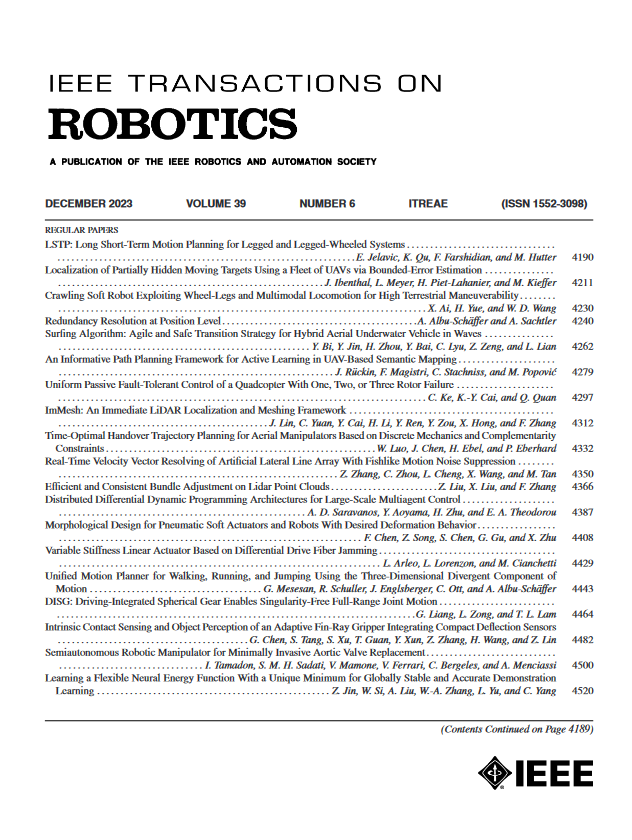Load-Transfer Suspended Backpack With Bioinspired Vibration Isolation for Shoulder Pressure Reduction Across Diverse Terrains
IF 9.4
1区 计算机科学
Q1 ROBOTICS
引用次数: 0
Abstract
Active suspended backpacks represent a promising solution to mitigate the impact of inertial forces on individuals engaged in load carriage. However, identifying effective control objectives aimed at enhancing human carrying capacity remains a significant challenge. In this study, we introduce a novel approach by integrating a limb-like structure-type (LLS) bioinspired vibration isolator, modeled using Lagrangian mechanics, into an active load-transfer suspended backpack to primarily alleviate human shoulder pressure, thereby constructing a human–robot interaction control framework for the system. Drawing from a double-mass coupled oscillator model, this approach formulates a vertical dynamics model for the human-backpack system, systematically exploring the principles of both static load transfer and dynamic load reduction on the human shoulder. Subsequently, a series-elastic-actuator-based controller with prescribed performance is proposed to simultaneously achieve trajectory tracking and ensure load motion within the limited range. Theoretically, we validate the input–output stability of the LLS model and guarantee the ultimate uniform boundedness of the closed-loop system. Simulation and experimental trials conducted across different terrain scenarios validate the effectiveness of the proposed method, highlighting reductions of 18.68% in metabolic rate during level ground walking, 9.58% in a staircase scenario, and 12.35% in a complex terrain, involving uphill, downstairs, and flat ground walking.负载转移悬挂背包与生物启发的隔振肩部压力减轻在不同的地形
主动悬挂背包代表了一个有希望的解决方案,以减轻惯性力对个人从事负载运输的影响。然而,确定旨在提高人类承载能力的有效控制目标仍然是一项重大挑战。在这项研究中,我们引入了一种新颖的方法,将一种采用拉格朗日力学建模的类肢结构型(LLS)仿生隔振器集成到主动负载转移悬挂背包中,以主要减轻人体肩部压力,从而构建了系统的人机交互控制框架。该方法从双质量耦合振荡器模型出发,建立了人-背包系统的垂直动力学模型,系统地探讨了人体肩部静态载荷传递和动态载荷减少的原理。随后,提出了一种具有规定性能的基于串联弹性作动器的控制器,以同时实现轨迹跟踪并保证负载在限定范围内运动。从理论上验证了LLS模型的输入输出稳定性,保证了闭环系统的最终一致有界性。在不同地形场景下进行的模拟和实验试验验证了所提出方法的有效性,突出表明在平地行走时代谢率降低18.68%,在楼梯场景中降低9.58%,在复杂地形(包括上坡、下楼和平地行走)中降低12.35%。
本文章由计算机程序翻译,如有差异,请以英文原文为准。
求助全文
约1分钟内获得全文
求助全文
来源期刊

IEEE Transactions on Robotics
工程技术-机器人学
CiteScore
14.90
自引率
5.10%
发文量
259
审稿时长
6.0 months
期刊介绍:
The IEEE Transactions on Robotics (T-RO) is dedicated to publishing fundamental papers covering all facets of robotics, drawing on interdisciplinary approaches from computer science, control systems, electrical engineering, mathematics, mechanical engineering, and beyond. From industrial applications to service and personal assistants, surgical operations to space, underwater, and remote exploration, robots and intelligent machines play pivotal roles across various domains, including entertainment, safety, search and rescue, military applications, agriculture, and intelligent vehicles.
Special emphasis is placed on intelligent machines and systems designed for unstructured environments, where a significant portion of the environment remains unknown and beyond direct sensing or control.
 求助内容:
求助内容: 应助结果提醒方式:
应助结果提醒方式:


